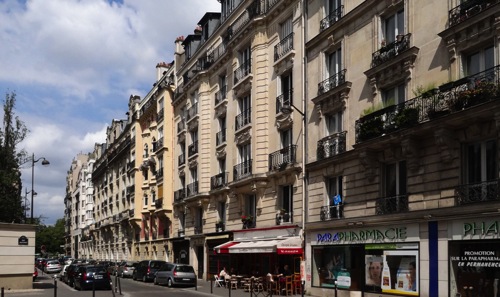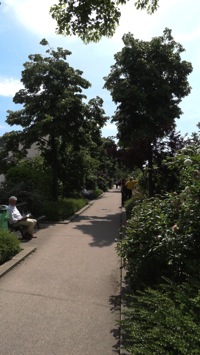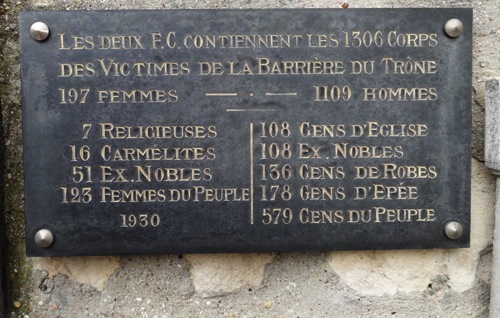Yesterday we went into Paris for the first time this trip. We delayed that foray because the weather has been so bad (it’s official: the worst May since the 1880’s) but yesterday started what is forecast to be a ten-day streak of good weather, so off we went with our friends Mary & Gilles.
When we stepped out of the train station, I stopped, looked around and got a big grin on my face. Laurie and I looked at each other and agreed: we felt as if we were home. We love this city, and as we’ve been here many times, so we’re quite comfortable making our way around the city. It was so nice to be back.
Paris is a city that rewards looking up; the buildings are (almost) all beautiful. In the 1870s, Baron Von Haussman, at the direction of Napolean III (nephew and step-grandson of the real Napolean; don’t ask) rebuilt Paris. He tore down many buildings and created the wide boulevards for which Paris is known. He also decreed that when new buildings went up, they had to be five stories high and of a certain architectural style. Where separate buildings were constructed on a block, the separate buildings had to have an architectural coherence, so that they looked good together, and the blocks looked good as a whole.

 We walked along Promenade Plantée, a converted train viaduct in the middle of the 12th arrondissement. Now it’s a beautifully planted walk above the city. This offers an unusual view of Paris, as the Promenade is about 30 feet above ground level for much of its route, so you’re always looking down on streets and buildings. This was a railroad track to Bastille until the 1960s, and was converted to a promenade in the 70’s.” We walked along Promenade Plantée, a converted train viaduct in the middle of the 12th arrondissement. Now it’s a beautifully planted walk above the city. This offers an unusual view of Paris, as the Promenade is about 30 feet above ground level for much of its route, so you’re always looking down on streets and buildings. This was a railroad track to Bastille until the 1960s, and was converted to a promenade in the 70’s.” |
 We visited Cimetiere Picpus, an unusual cemetery. To understand it, you’ll need a tiny bit of French history. In its late stages , the French Revolution went through a pretty horrific time, known as the Terror. During this time, even the faintest suspicion of non-Revolutionary zeal – in fact, simply the accusation, true or false, of not being fully committed to the Revolution – was sufficient for a person to be tried, convicted and sent to the guillotine. Thousands were executed in Paris. In the last month of the Terror, over 1,300 people were executed in nearby Place Nation, and buried in two common graves at a convent, now the Cimetiere Picpus. Afterwards, for a reason lost to history, the only people who could be buried there were those who had ancestors who had died in the Terror.As a result, the Picpus cemetery is full of the most aristocratic names in French history. One of these is well-known to Americans: Lafayette, who came to America to fight on General Washington’s side in the American revolution. Lafayette was a hero to Americans, and to the French people for his roles in both the American Revolution and the French Revolution. He is buried in the Picpus cemetery, under soil from Bunker Hill (Boston, the first real battle of the American Revolution); his grave, and an American flag, are maintained by the Paris chapter of the Daughters of the American Revolution. We visited Cimetiere Picpus, an unusual cemetery. To understand it, you’ll need a tiny bit of French history. In its late stages , the French Revolution went through a pretty horrific time, known as the Terror. During this time, even the faintest suspicion of non-Revolutionary zeal – in fact, simply the accusation, true or false, of not being fully committed to the Revolution – was sufficient for a person to be tried, convicted and sent to the guillotine. Thousands were executed in Paris. In the last month of the Terror, over 1,300 people were executed in nearby Place Nation, and buried in two common graves at a convent, now the Cimetiere Picpus. Afterwards, for a reason lost to history, the only people who could be buried there were those who had ancestors who had died in the Terror.As a result, the Picpus cemetery is full of the most aristocratic names in French history. One of these is well-known to Americans: Lafayette, who came to America to fight on General Washington’s side in the American revolution. Lafayette was a hero to Americans, and to the French people for his roles in both the American Revolution and the French Revolution. He is buried in the Picpus cemetery, under soil from Bunker Hill (Boston, the first real battle of the American Revolution); his grave, and an American flag, are maintained by the Paris chapter of the Daughters of the American Revolution. |
Below, the plaque to the victims of the Terror, buried in the common graves. Note the sixteen Carmelite nuns, whose actions have become famous. Each nun, as she approached the guillotine, turned to the Mother Superior and said, “Permission to die?” When given permission, the nun then sang a hymn until the blade fell. Several movies and an opera have been made about them.

That, along with lots of walking (you must walk Paris to really see it), was our first day “home.”
